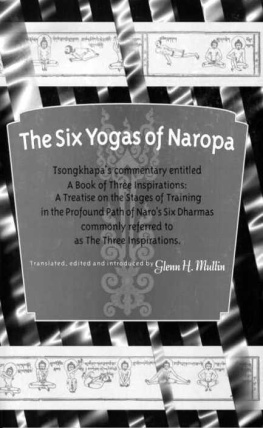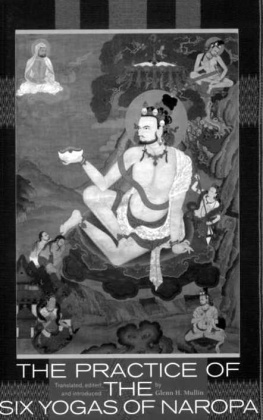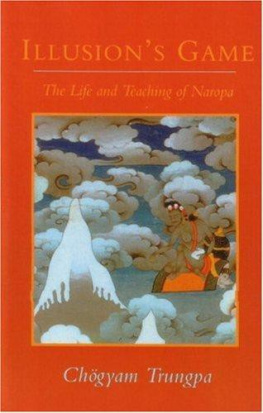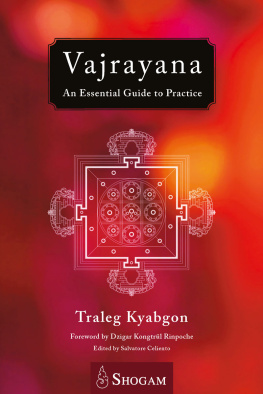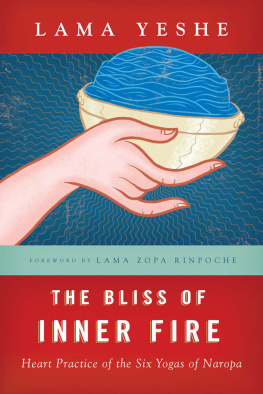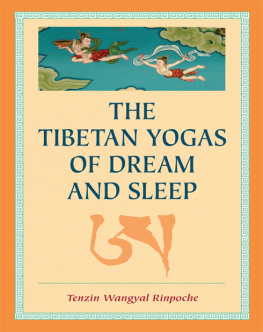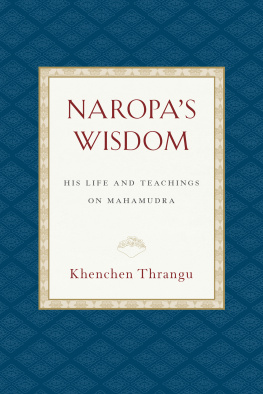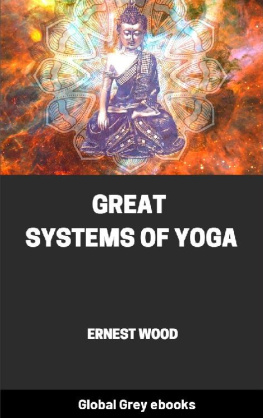THE SIX YOGAS OF NAROPA
THE SIX YOGAS OF NAROPA
Tsongkhapa's commentary entitled A Book of Three Inspirations: A
Treatise on the Stages of Training in the Profound Path of Naro's Six
Dhartnas, commonly referred to as
The Three Inspirations
Translated, edited and introduced by
Glenn H. Mullin



Table of Contents
A Book of Three Inspirations: A Treatise on the Stages of Training in the Profound Path of Naro's Six Dharmas by Tsongkhapa Lobzang Drakpa
Dedicated to the late Italian monk Stephano Piovella, and the late British monk Kevin Rigby, both very dear friends on the path to enlightenment, and both of whom made great efforts to fulfill the visions of the buddhas and bodhisattvas. May they pick up in future incarnations from where they left off in this, and catch the wave of meritorious energies everywhere surging since time without beginning.
Preface
Anyone who has read more than a few books on Tibetan Buddhism will have encountered a reference to the Naro Choe Druk (Tib. na ro'i chos drug), a phrase that renders literally as "Naro's Six Dharmas," but is more often encountered in English translation as "the Six Yogas of Naropa." These six-inner heat, illusory body, clear light, consciousness transference, forceful projection, and the bardo yoga-represent one of the most popular Tibetan Buddhist presentations of yogic technology to come from India to the Land of Snows.
The Tibetan word choe (Tib. chos) in the expression Naro Choe Druk is a translation of the Sanskrit term dharma, which means "doctrine," "teaching," "instruction" or "yogic training." Druk means "six." Thus the system can be called Six Dharmas, Six Doctrines, or Six Yogas. I generally use "the Six Yogas of Naropa," or simply "the Six Yogas," because these are the forms best known to Western readers. Occasionally I resort to the more literal "Naro's Six Dharmas," although whenever I do so I enclose the phrase in quotation marks in order to indicate that I am honoring the Tibetan form of the name, Naro Choe Druk.
Tibetan literature randomly refers to the illustrious Indian Buddhist master after whom this tradition is named as Naro, Naropa, and Naropada (born 1016). Naropa was a disciple of the Indian mahasiddha Tilopa (b. 988). The lineages that Naropa gave to his Tibetan lay-disciple Marpa Lotsawa (lit. "Marpa Translator"; b. 1012), especially that of the Six Yogas, came to pervade thousands of monasteries and hermitages throughout Central Asia, regardless of sect. This is certainly true within all the Sarmai Choeluk, or "New Schools," such as the Kadampa, Kargyupa, Sakyapa, Jonangpa and Gelukpa. In addition, the Six Yogas have also gradually become absorbed into most of the Nyingma Choeluk, or "Older Schools."
The treatise on the system written by Tsongkhapa the Great (1357- 1419)-A Book of Three Inspirations: A Treatise on the Stages of Training in the Profound Path of Naro's Six Dharmas-is regarded as one of the finest on the subject to come out of the Land of Snows. Lama Tsongkhapa was the forefather of the Gelukpa school (Tib. dGe lugs; lit. "Order of Excellence"), which quickly swept across Central Asia and became the largest single school of tantric Buddhism. He was also the guru of the First Dalai Lama (b. 1391). His treatise has served as the fundamental guide to the system of the Six Yogas of Naropa as practiced in the more than three thousand Gelukpa monasteries, nunneries and hermitages across Central Asia over the past five-and-ahalf centuries.
The Gelukpa lineage came down over the generations to the present day. The principal transmission holder, when I arrived in India in 1972, was Kyabjey Trijang Rinpochey, the Junior Tutor of His Holiness the Dalai Lama. He in turn passed it to numerous disciples.
I was in Dharamsala in 1973 when Kyabjey Rinpochey delivered his last transmission on Naropa's Six Yogas. At the time I was studying Tibetan language, philosophy and meditation at the Buddhist Studies Program initiated by H. H. the Dalai Lama as part of the activities of his recently established Library of Tibetan Works and Archives in Dharamsala. A few months into the program it was announced that the Junior Tutor to His Holiness, the very venerable and very elderly Kyabjey Trijang Rinpochey, would be giving a teaching in the museum room, the largest space in the building. The subject would be the Six Yogas of Naropa, and the recipients would be a large group of Tibetan yogis, hermits, monks and nuns. We Westerners couldn't attend, but if we liked we could sit in an adjoining room and listen through the sound system.
The Dalai Lama's Junior Tutor was considered to be one of the greatest living masters to come out of Tibet, and was regarded as a living buddha by the Tibetan community. News of his discourse had travelled throughout the refugee communities of India and Nepal, and great lamas began to roll into town from all directions. One monk who was pointed out to me was said to have spent more than forty years in meditation in the mountains. There were dozens of others with twenty or more years of solitary retreat under their belts.
Rinpochey spoke six hours a day for many, many days, using the text of Lama Tsongkhapa as his focus. One day one of the yogis coming out of the room at the end of a session looked at me and said, "Really, what a buddha he is!"
When this great lama passed away a few years later, the Tibetan spiritual community mourned the loss of one of the last of the supergreats to come out of Tibet. When I think back twenty-two years ago to the faces in the front couple of rows at that teaching, many of them have today come to rank among the foremost lamas in the Gelukpa school.
Essentially there are two main ways to teach Tsongkhapa's A Book of Three Inspirations: by means of a shey tri (Tib. bshad 'khrid), or "explanatory discourse"; and by means of a nyam tri (Tib. nyams 'khrid), or "experiential discourse." The former is what is most often received first. Usually this kind of teaching is given by a senior lama at a large public gathering, and entails a word-for-word reading and explanation of the text. The discourse of Kyabjey Trijang Rinpochey belongs to this latter category, as does the teaching I received from His Holiness the Dalai Lama in 1990.
Those who have attended a public teaching of the text and want to pursue the training will arrange to receive the second type of teaching, the "experiential discourse," which is given more privately. Here all philosophical and historical discussions are set aside, and the focus instead is placed on the actual yogic and meditative applications. This was the teaching style in Gelukpa practice hermitages; the resident teacher would impart a few pages of the text, and the disciples would then meditate for a few weeks or months on the material that had been covered. Only when the teacher felt that the desired inner experiences had been generated would he teach the next section of the text. Most practitioners receiving an "experiential teaching" of the text from their personal lama would already have received the "explanatory teaching," together with the appropriate empowerments, from a senior lineage lama.

